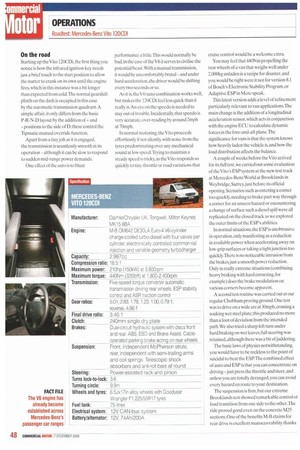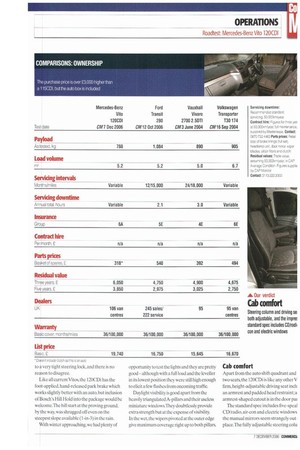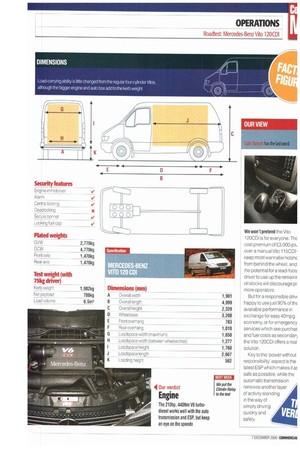It's a Vito —.but with M-B's latest 3.0-litre 116. If 40 7 % ; the purchase cost doesn't put you oft the fueroi - ;
Page 46

Page 47

Page 48

Page 49

Page 50

Page 51

If you've noticed an error in this article please click here to report it so we can fix it.
economy may come as a pleasant surprise
European manufacturers are showing no signs of relenting in their quest to develop the most powerful van. You'd think the VWTransporter's five cylinders, 172hp and 400Nm would be enough. hut a certain Stuttgart manufacturer disagrees. Having already extracted 150hp from its Ofv1646 2.1-litre four-cylinder engine. Mercedes-Benz has now shoehorned its latest 0M642 3.0-litre V6 turbo-diesel into the Vito to create the 120CDi.
The V6, which is already established across M-B's passenger car ranges, has 24 valves and a variable-geometry turbocharger, with alloy block and heads. Its third-generation common-rail fuel system feeds the engine courtesy of the latest piezoelectric injectors and an operating pressure hike from 1.351) to 1,61.)0bar. The fast-acting injectors work by applying an electrical signal to a piezo crystal, causing it to contract and open the eighthole injector nozzle with up to four injection events per cycle.
The first two pilot injections begin the combustion process in a gentle and controlled manner which prevents the typical diesel knock. The main injection event is followed by another post-injection which aids complete combustion for low emissions.
llie system will soon he fitted to the Vito's four-cylinder CDi engine range,and has already appeared on the new Sprinter:Me resulting numbers are impressive —201hp at 3.800rpm and 440Nm 1;rom 1410 to 2,40Orpm.The Vito 120CDi comeAith a five-speed torque-converter automatic transmission as standard.
M-B isn't expecting the average parcel delivery service or painter and decorator to sign up for V6 power. alt hough it is available across the Vito range. Its intended market is the emergency service sector:shortly before our roadtest, one of the UK's highest-profile police.forces placed an order for 10 examples for fast response duties.
Productivity
with any torque-cons erter transmission (even with modern lock-up technology) t here's a degree of slippage —so combined with a 200hp-plus engine you'd expect Pretty dismal fuel economy. So how do figures of over 40mpg unladen and 30mpg laden sound? The unladen figure is as good as the Vito 11 ICI and better than the 115CD1.
Granted, fuel economy would probably plummet if you caned it all the time —but y( don't need to. Decent progress can be mad on a whiff of throttle.
4itiLIANyiug ability is little changed fn. thel6gular four-cylinder Vitos. although th combination of bigger engine and auto box adds 27kg totbe kerb weight.Two GVW options arc available: 2.770 and31,94(i itg: i i The I 20CDi model is an#140,11 ' the full range of body options. our Wst model being a kiw-roof, long-wheelbase version with a pair of side loading doors and barn r doors. It had a full steel unglazed bulkhead although many potential buyers may be rm interested in the crewcab Dualiner layout which offers five or six seats while retainin2 useful amount of loadspace.
All Vitos come with a full-width undemi storage facility accessible from the loadspa Our van's two individnal wik;insfeii _ h aual passenger set-up let the top of the ' A provide a usefuttnounting position Agin equipment and the like. while IV:tent of space for anything e Istt hat 1 On the road Starting up the Vito 120CDi, the first thing you notice is how the infrared ignition key needs just a brief touch to the start position to allow the starter to crank on its own until the engine fires.which in this instance was a bit longer than expected from cold.The normal gearshift plinth on the dash is occupied in this case by the automatic transmission quadrant. A simple affair, it only differs from the basic P-R-N-D layout by the addition of + and —positions to the side of D: these control the Tipmatic manual override function.
Apart from a tiny jolt as it is engaged, the transmission is seamlessly smooth in its operation — although it can be slow to respond to sudden mid-range power demands.
One effect of the auto is to blunt performance a little:11ns would normally be bad, in the case of the V6 it serves to civilise the potential bea.st.With a manual transmission, it would be uncomfortably brutal and under hard acceleration, the driver would be shifting every two seconds or so.
As it is, the V€/auto combination works well, hut makes the l 20CDi feel less quick than it really is. An eye on the speedo is needed to stay out of trouble. Incidentally, that speedo is very accurate, over-reading by around 2mph at 70mph.
In normal motoring. the Vito proceeds effortlessly if not silently, with noise from the tyres predominating over any mechanical sound at low speed.Trying to maintain a steady speed is tricky, as the Vito responds so quickly to tiny throttle or road variations that cruise control would be a welcome extra.
You may feel that 440Nm propelling the rear wheels of a van that weighs well under 2,000kg unladen is a recipe for disaster,and you would be right were it not for version 8.1 of Bosch's Electronic Stability Program, or Adaptive ESP in Merc-speak.
This latest version adds a level of refinement particularly relevant to van applications.The main change is the addition of a longitudinal acceleration sensor, which acts in conjunction with the engine ECU to calculate dynamic forces in the fore-and-aft plane.The significance for vans is that the system knows how heavily laden the vehicle is, and how the load distribution affects the balance.
A couple of weeks before the Vito arrived for its full test, we carried out some evaluation of the Vito's ESP system at the new test track at Mercedes-Benz World at Brooklands in Weybridge,Surrey,just before its official opening. Scenarios such as entering a corner too quickly, needing to brake part way through a corner for an unseen hazard or encountering a change of surface such a diesel spill were all replicated on the closed track as we explored the outer limits of the ESP's abilities.
In normal situations, the ESP is unobtrusive in operation, only manifesting as a reduction in available power when accelerating away on low-grip surfaces or taking a tight junction too quickly.There is no noticeable intrusion from the brakes,just a smooth power reduction. Only in really extreme situations (combining heavy braking with hard cornering, for example) does the brake modulation on various corners become apparent.
A second test routine was carried out at our regular Chobham proving ground. One test was to drive on a wide arc at 30mph.crossing a soaking wet steel plate:this produced no more than a foot of deviation from the intended path. We also tried a sharp left turn under hard braking on wet leaves: full steering was retained, although there was a bit of juddering.
The basic laws of physics notwithstanding, you would have to be reckless to the point of suicidal to beat the ESP. The combined effect of auto and ESP is that you can concentrate on driving —just press the throttle and steer, and unless you are totally deranged, you can avoid every hazard en route to your destination.
The suspension is firm,but our extreme Brooklands test showed remarkable control of load transition from one side to the other:11e ride proved good even on the concrete M25 sections. One of the benefits M-B claims for rear drive is excellent manoeuvrability thanks
to a very tight steering lock, and there is no reason to disagree.
Like all current Vitos, the 120CDi has the foot-applied, hand-released park brake which works slightly better with an auto. but inclusion of Bosch's Hill Hold into the package would be welcome.The hill start at the proving ground, by the way, was shrugged off even on the steepest slope available (1-in-3) in the rain.
With winter approaching, we had plenty of opportunity to test the lights and they are pretty good — although with a full load and the leveller in its lowest position they were still high enough to elicit a few flashes from oncoming traffic.
Daylight visibility is good apart from the heavily triangulated A-pillars and their useless miniature windows.They doubtlessly provide extra strength but at the expense of visibility. In the wet,the wipers pivoted at the outer edge give maximum coverage right up to both pillars.
Cab comfort
Apart from the auto shift quadrant and two seats, the 120CDi is like any otherV firm. height-adjustable driving seat inch an armrest and padded head restraint; a armrest-shaped cutout is in the door pal The standard spec includes five-speal CD/radio, air-con and electric windows the manual mirrors seem strangely out place. The fully adjustable steering colu carries the single standard air bag. Without the optional over-screen shelf, the lack of oddments storage within reach of the driver is noticeable. The cubby above the park brake release will take a fag packet or Blackberry; there arc fair sized door pockets; and a dashtop bin and glovebox able to hold A4-sized documents and clipboards.The non-lockable glovebox lid incorporates cup-holders,earcl holders and penholders. A combined ashtray and cup-holder lives to the left of the dashmounted gear lever and there's another popout cup-holder at the extreme left of the dash.
Switch gear on top of the dash amounts to hazards in the centre, traction control override on the left and loadspace light and door locking to the right. Instruments are a large 180' speedo. a smaller rev counter on left.and a fuel gauge on right; the yellow display panel shows gear status (although not which gear is engaged in auto mode).clock. tripmeter, digital speed readout in km/h and external temperature. Dash lighting is white on black,turning yellow at night.The radio display looks classy but the screen resolution is somewhat low. •
OUR VIEW
We won't pretend the Vito 12000i is for everyone. ThE cost premium of £3,000-plt., over a manual Vito 115CDI keep most wannabe hotshc from behind the wheel, and the potential for a lead-footE driver to use up the remainir oil stocks will discourage pi, more operators.
But for a responsible driv( happy to use just 90% of thE available performance in exchange for easy 40mpg economy, or for emergency services which see purchaE and fuel costs as secondan the Vito 120CDi offers a real solution.
Key to the 'power without responsibility aspect is the latest ESP which makes it aE safe as possible, while the automatic transmissIon removes another layer of activity standing in the way of simply driving quickly and safely.


































































































































































































